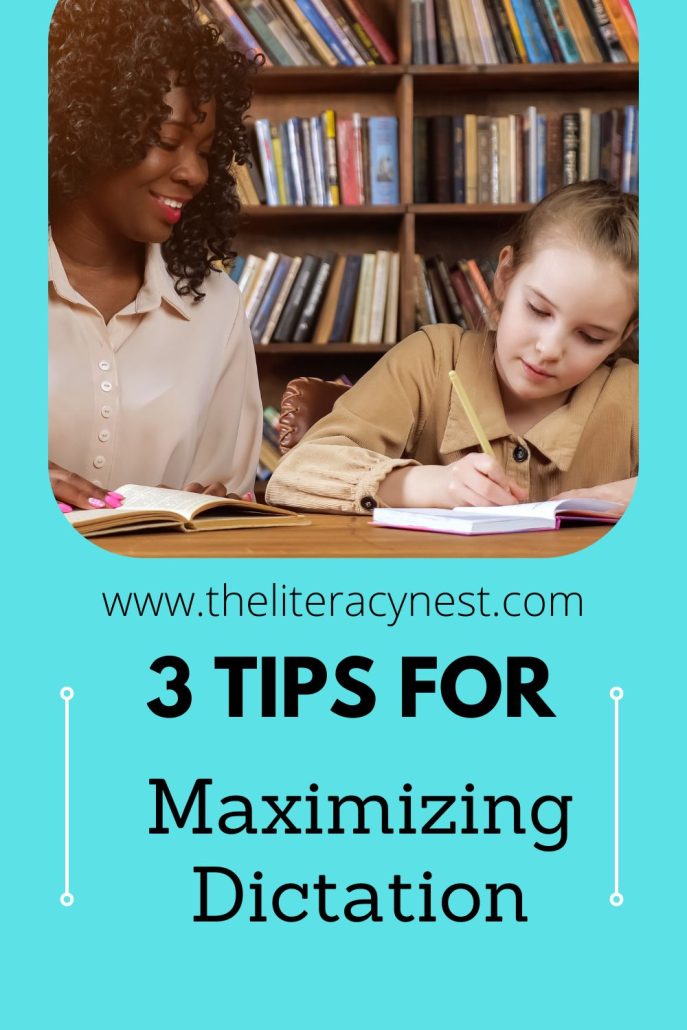3 Tips for Maximizing Dictation

Dictation is an important part of each Orton-Gillingham lesson. It is when everything comes together. Dictation is the You Do portion of the gradual release of responsibility. When looking at this portion of the lesson, there are a few points where you can begin maximizing dictation.
Here are 3 quick tips for maximizing the dictation portion of your Orton-Gillingham lesson:
1. Provide a structured paper
Some students will be ready to set up their own paper by folding it in half and heading in on their own. However, other students will need a very structured format. For those students, I provide my own, already lined and ruled paper. This paper has a section for What Says? at the top. S.O.S. in the middle, and sentence Dictation at the bottom.
Watch this video for a peek at the paper and how I use it with my students!
As I work with students over a longer amount of time, I transition them to using their own paper that they fold, head, and number for themselves.
2. Underline the words that follow the rule
During the sentence dictation portion of the lesson, after students write out the sentence that I’ve dictated to them, I prompt them to underline any words in the sentence that follow the skill or concept that we are working on.
I’ll say: “Okay, so what we’re we working on today? Find those words and underline them”
After my students underline each of those words, I ask them to read the underline words to me. It can also be fun to use gel highlighters to highlight the words instead of underlining them!
3. Take a break during S.O.S. then circle back
In an Orton-Gillingham lesson, S.O.S. is a multi-sensory spelling strategy that stands for Simultaneous Oral Spelling.
Learn more about Using the S.O.S. Strategy!
With my students, I do the S.O.S. portion of the lesson right after the What Says? portion… however, I like to take a break after they’ve written all of the words.
After we’ve gone through all of the steps of S.O.S., instead of asking my students to go back and read each of the words to me, I first move on to sentence dictation. Once we complete sentence dictation as described above, I’ll circle back to the S.O.S. section and I’ll ask the student to read each word from the S.O.S. section to me.
Why? Because it’s a great measure of just how much my student has retained and just how much he or she is building toward mastery. That break after S.O.S. of moving on to sentence dictation and then circling back to the words will give you great insight into if they are building towards mastery.
Want more practice with S.O.S.? Check out Orton-Gillingham Activities: FREE SOS Spelling Game Multisensory Strategies.
Remember, they’re not just reading these words aloud for you! They’re reading them aloud for themselves. This will reinforce independence and self-checking. If they do stumble over any of the words, absolutely make a note for next time!
For more creative ways you can incorporate writing into your Orton-Gillingham lessons, listen to this episode of the Together in Literacy Podcast: 2.8 Incorporating Writing in Structured Literacy Lessons
Hopefully, these tips will help you be a bit more reflective on maximizing your dictation lesson, while also thinking about the next steps for your students as they work toward mastery.
To learn more about how to support writing, join Building Readers for Life Academy.
Building Readers for Life Academy is a monthly membership program that empowers educators AND families by diving into structured literacy and strategies for ALL learners. With BRFL Academy, you’ll learn what it takes to help EVERY student become a reader for life.







